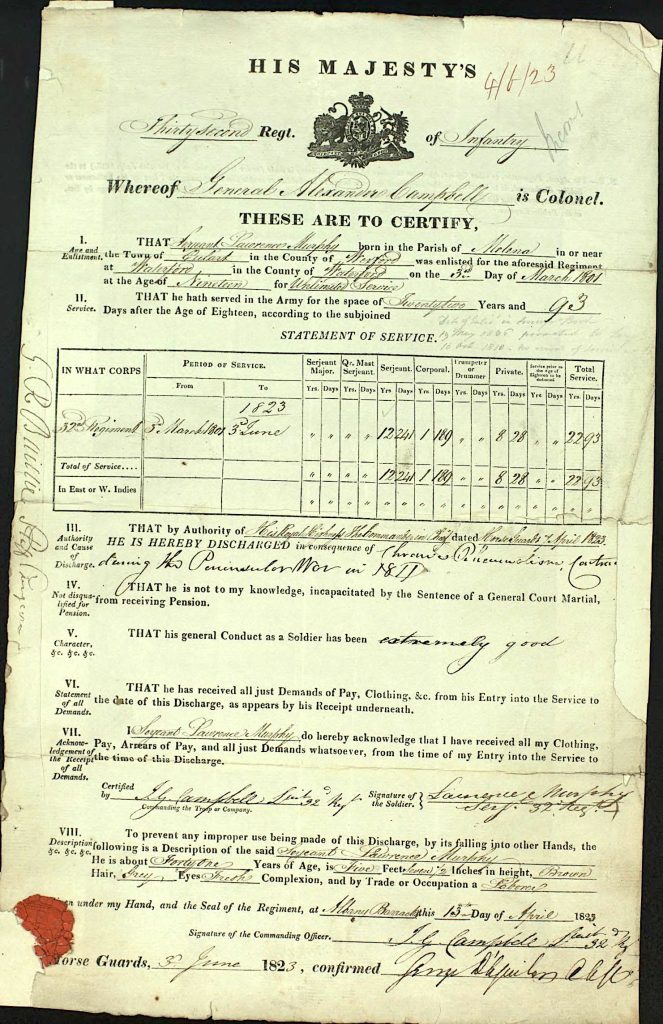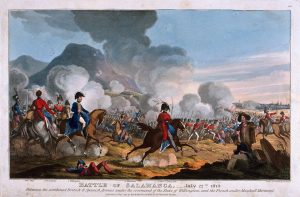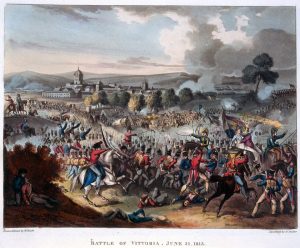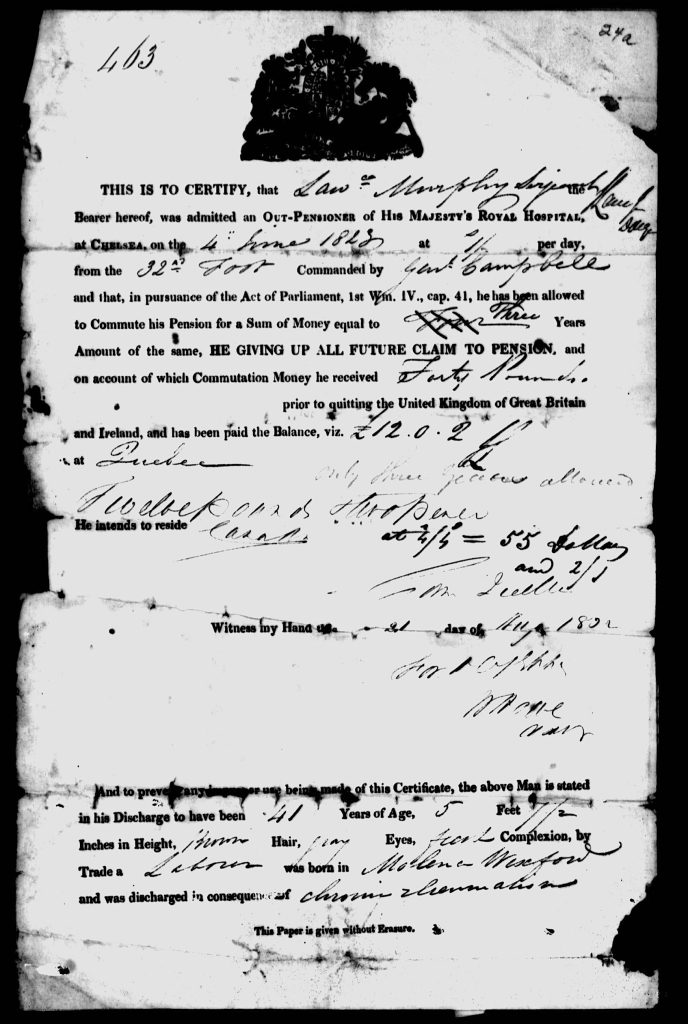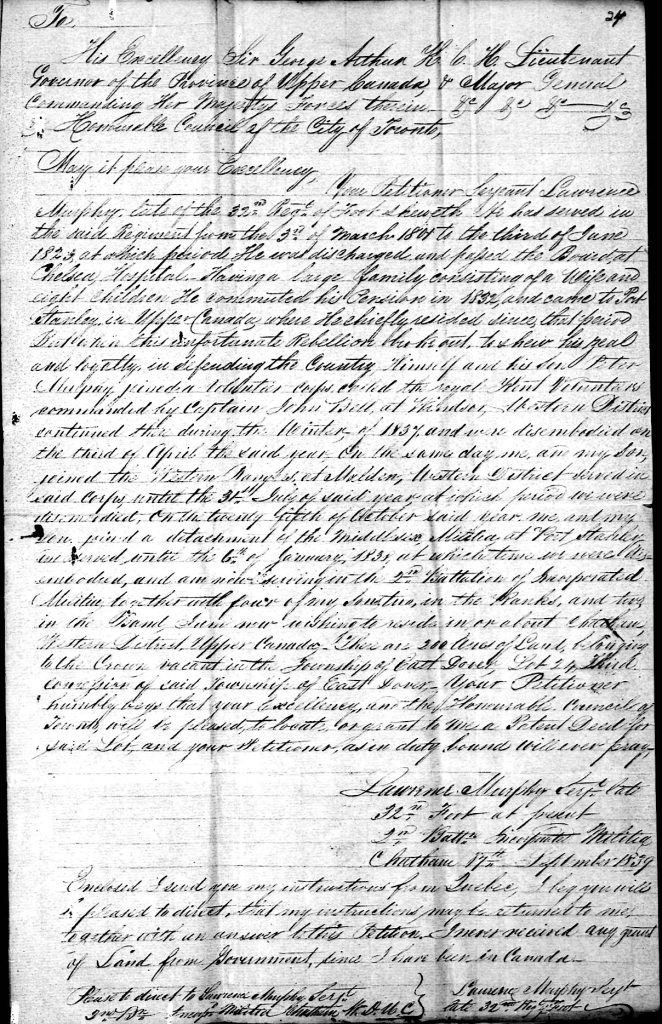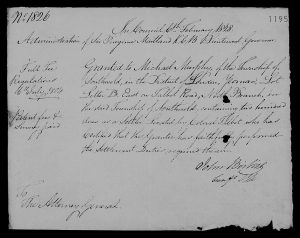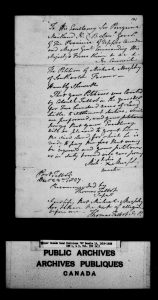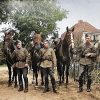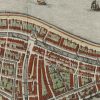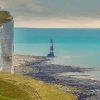In tracing the history of the wave of emigration of the Murphy and Nolan families to the United States, the story truly starts with one man: Lawrence Murphy. His name appears in the genealogies of the early settlers of Tecumseh, Nebraska, but little has been known of his life until now. And what a story it is!
Born in Ireland, he joined the British Army at 19, and fought in several major campaigns including the Peninsular Wars and the Battle of Waterloo. By 1831 he would emigrate to Canada with his wife and eight children, later defending that country in the Rebellion of 1837. Failing to secure land for himself, the Murphy family moved on to the United States, joining another Murphy in the founding of an Irish township in Illinois. His son James became the first Irish settler in Tecumseh, Nebraska, where over the following decades many more would follow.
Born into a rebellious time
Lawrence Murphy was born in 1782 in Meelnagh (Maoileanach), Oulart (Abhallort), Co. Wexford. Meelnagh is one of the smallest townlands in Ireland, at just 13 acres. Small, but historically very significant. The old graveyard at Meelnagh goes back to early Christian times.
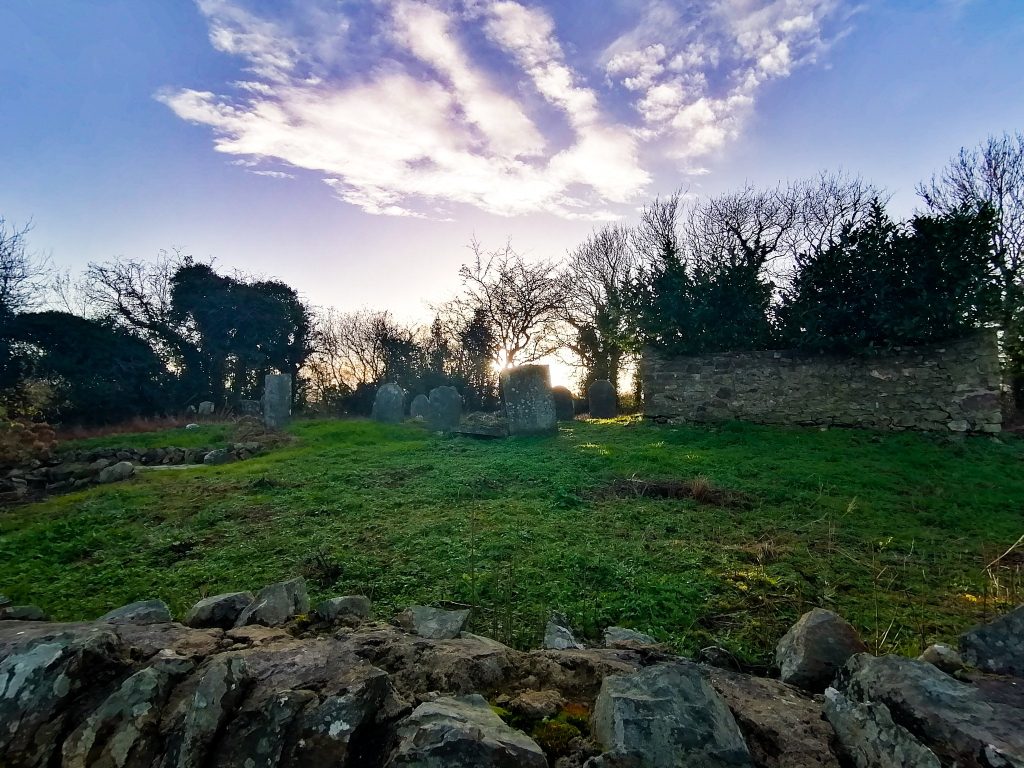
When Lawrence was 16, the Irish Rebellion of 1798 took place, with nearby Oulart Hill being a focal point of the uprising. It would be the first rebellion he witnessed, and foreshadow many more that he would later be invovled in.
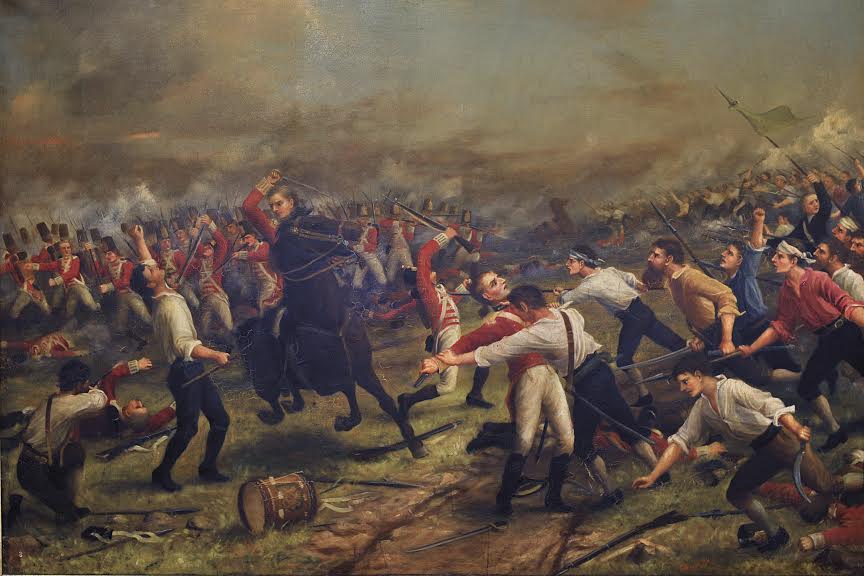
Today, the monument at Tulach a’ tSolais commemorates the events of 1798. “The construction of a tulach or burial mound, as a place of connection between the world of the living and the ‘other world’ was common in ancient Ireland. The United Irishmen’s uprising of 1798, fuelled by the revolutionary example of the United States and France, took place at Oulart Hill. Victory led to the establishment of the fledgling Wexford Republic; defeat at Vinegar Hill three weeks later, on the summer solstice, June 21st, marked its eclipse.”
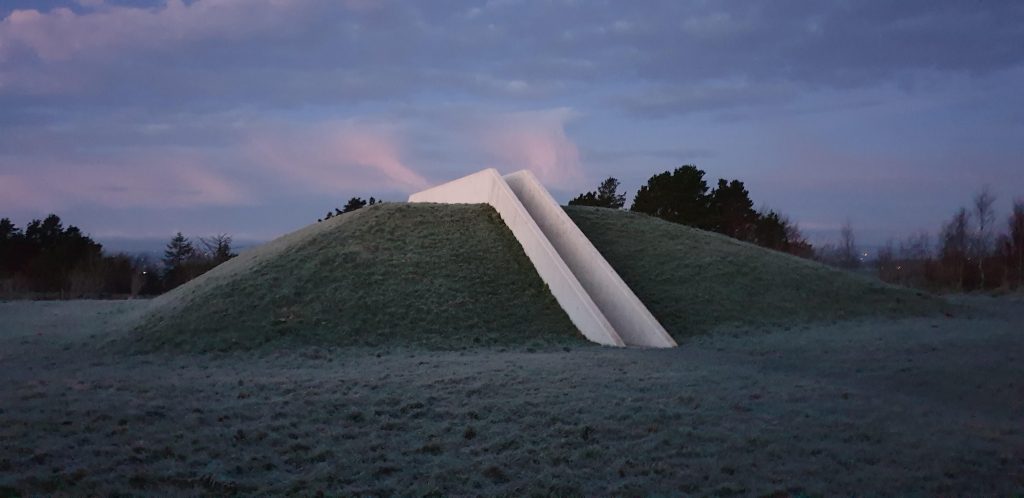
Meelnagh cemetery has only one Murphy noted by Cantwell in 1982 >. Tracing the earlier ancestors of Lawrence Murphy is challenging, like most Irish ancestry before 1800. Church records in the area date back only to around 1830.

Waterford, 1801
On a Tuesday morning in early March, 1801, at the age of 19, Lawrence presented himself at the Military Barracks in Waterford, to join the British Army for “unlimited service”.
He served in the British Army for 22 years, and was discharged on June 3rd, 1823 as Sergeant Lawrence Murphy of the 32nd Regiment, under General Alexander Campbell. His discharge certificate gives us detailed information about his time in the army.
Peninsular War
In 1809, Lawrence was promoted from Private to Corporal, and one and a half years later, towards the end of 1810, he became Sergeant. The 32nd regiment was involved in much heavy fighting. It deployed to the Peninsular War in 1808, fighting at Rolica (1808) and Vimiero (1808), and then took part in the retreat to Corunna (1809). It was sent on the Walcheren Expedition to the Netherlands in 1809, before joining the Irish garrison in 1810. 1st Battalion was sent back to the Peninsula in 1812, fighting at Salamanca (1812), Burgos (1812), Vitoria (1813), Sorauren (1813), Nivelle (1813), Nive (1813), Orthes (1814) and Tolouse (1814). It then returned to Ireland. Less than a year later, it was redeployed to the Continent to fight at Quatre Bras and Waterloo in 1815.
In the Peninsular campaign, Lawrence contracted chronic Rheumatism, which would later be the reason for his discharge from the Army in 1823. The uniforms below show the 32nd regiment, as would have been worn by Lawrence.
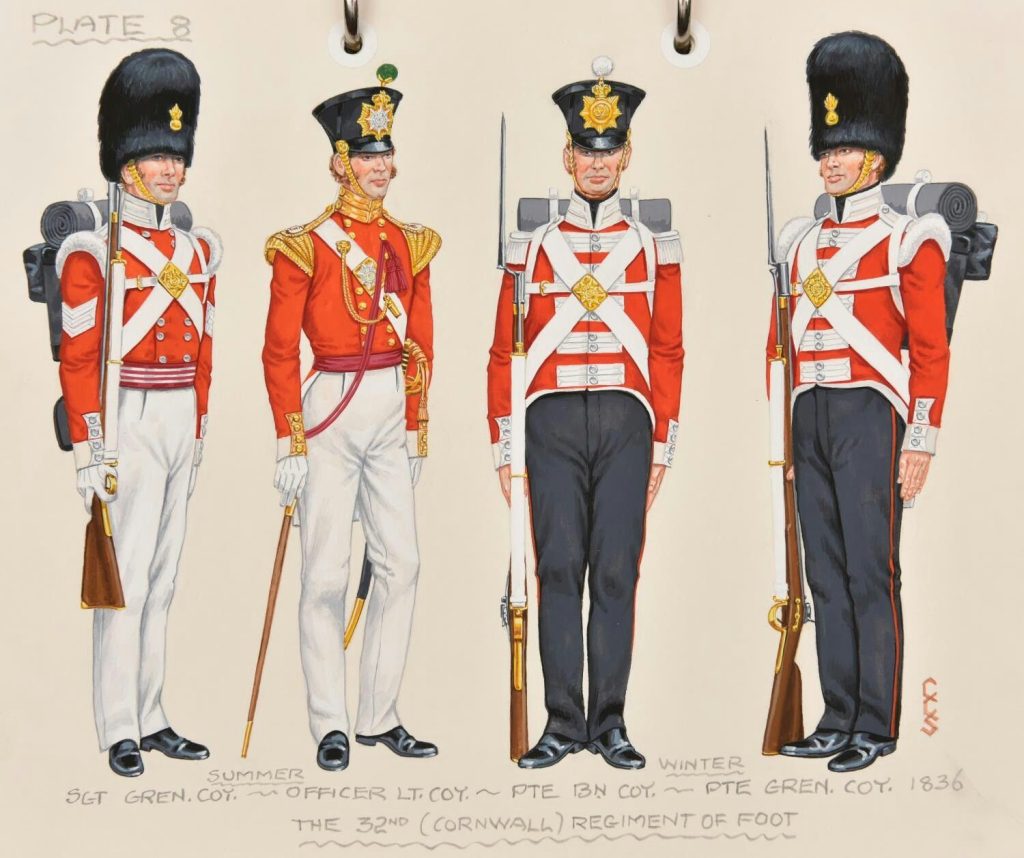
Battle of Waterloo
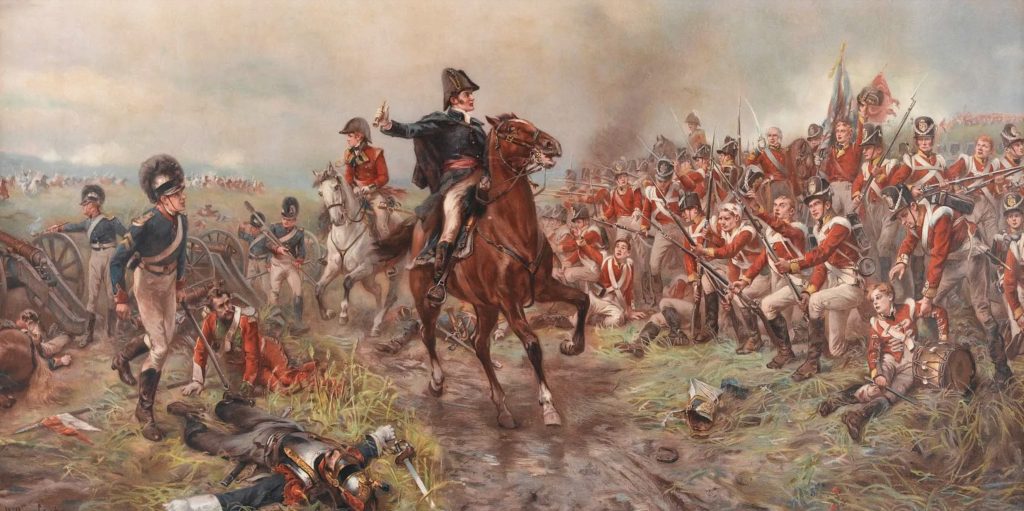
Lawrence’s 32nd regiment was heavily involved in the Battle of Waterloo, which was fought on Sunday 18 June 1815. His son Samuel Murphy’s biography confirms Lawrence was present. The regiment fought at the Battle of Quatre Bras, arriving about 3 pm on June 16th, just in time to help halt the French advance. Two days later at the Battle of Waterloo the regiment was stationed opposite the French main attacks, standing their ground before attacking Napoleon’s assaulting troops [>].
A full list of the movements of the 32nd regiment between 1802 and 1815 shows the incredible variety of travel and campaigns that Lawrence was involved in [>].
- 1802: Waterford; Dundalk
- 1803: Kilkenny; July – Dublin uprising
- 1804: Longford; Curragh
- 1805: Bandon; Loughrea; ordered on foreign service; Monkstown; did not embark
- 1806: Cork; Clonakilty
- 1807: Bandon; July – to Portsmouth; to Copenhagen; November – Lewes; Gosport; received draft of 99 men from 2/32; December – ordered on secret expedition but did not embark; Falmouth
- 1808: Falmouth; June – to Gibraltar; headquarters to Sicily; Cadiz; July – Portugal; ROLICA; VIMIERO; October – into Spain
- 1809: Retreat to Corunna; February – England; Horsham; July – Downs; September – Walcheren; Antwerp; December – to England
- 1810: Portsmouth; Hailsham; received draft from 2/32; July – Bexhill; August – Grand Review at Brighton; September – Guernsey
- 1811: Guernsey; June – to Portugal; July – Lisbon; received 309 men from 2/32; Villa de Porco; Chiras
- 1812: Ciudad Rodrigo; Estremos; Elvas; Llerena; Escaldos de Olma – much sickness; April – received 163 men from 2/32; Castello Branco; Salamanca forts; SALAMANCA; siege of Burgos; December – received 106 men from 2/32; St Jago
- 1813: St Jago; Vittoria; Blockade of Pamplona; Sorauren; Bidassoa; NIVELLE; Ustaritz; NIVE; received two drafts of men from 2/32
- 1814: Villefrancha; received 114 men from 2/32; ORTHEZ; Bourdeaux; July – to Cork; Fermoy; August – received 138 men from 2/32; November – received remaining 2/32 men
- 1815: January – ordered to America; April – Monkstown; ordered to Belgium; Ostend; Brussels; Quatre Bras; WATERLOO; Paris; December – Boulogne; to England.
The historical record of the 32nd Regiment gives full details of the campaigns that Lawrence took part in, and makes interesting reading. The years after Waterloo were far less frantic, with the regiment spending time in England, Ireland, and Corfu.
And still time to raise a family …
It’s astonishing that amongst all of this military service from 1801 to 1823, Lawrence was also able to start a family. He married Elizabeth Harley, probably around 1816. Their first child, Ann, was baptised on 27th December 1816 in the catherdral at Portsmouth. Bridget, Peter, Samuel and James were likely all born in England, and their 6th child, Thomas, was baptized in Enniscorthy in 1829.

- Ann Murphy. Bapt. 27 Dec 1816, Portsmouth. Godparents were Joannis (?) Sweeney and Maria Corrigan. [>] The baptism took place at St John’s Catholic Cathedral in Portsmouth, and it’s notable in the records that most of the entries are for Irish people. Married Joseph Hemming 1833, then John Cory.
- Bridget Murphy. Born 24 Jan 1819. Married Asahel Strawn.
- Peter H. Murphy. Born 1820. Married Mary Ann Young.
- Samuel Murphy. Born 1823, Staffordshire, England. Married Parnel Abiah Cory.
- James Murphy. Born 1825, England. Married Catherine Ahern.
- Thomas Murphy. Baptized 23 Dec 1829 at Enniscorthy. Witnesses John & Abigail Connors >. In 1850 living in Franklin, Il. with brother James and Catherin Ahern. Married Anastasia Finn (?).
British Royal Navy
5 years after being discharged, Lawrence joined the British Navy on September 5th, 1828 [>]. His rank was “Able Seaman”, joining the ship H.M.S. Samarang, a 28-gun, teak, Atholl-class sixth rate of the Royal Navy. She was launched at Cochin in 1822 by the East India Company.
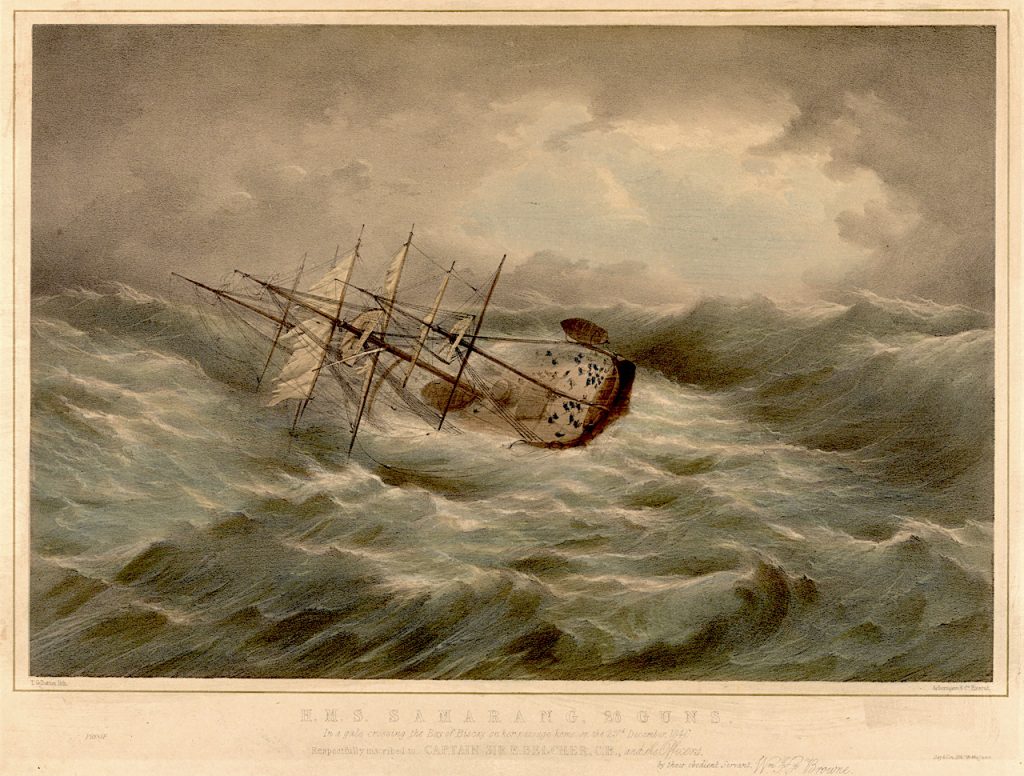
On the 6th of September 1828, Samarang departed Portsmouth for Plymouth and the Mediterranean station. On October 7th, the ship arrived at Malta. It primarily served in the Mediterranean area for the next several years [>]. Per son Samuel’s biography, Lawrence spent three years in the Navy.
Emigration to Canada
Having completed service in both the British Army and Navy, Lawrence was attracted to a new adventure entirely: making his mark in the New World.
Lawrence Murphy and Elizabeth Harley emigrated to Canada in 1832.
On Monday, August 27th, 1832, an entry in the Montreal Emigrant Society journal lists Laurence Murphy from Wexford and wife, and 6 children arriving in Quebec. 2 under 14, 3 under 7, and one infant (a total of 8 people). > The family are sent to Brockville, a city on the St. Lawrence river just before it broadens out into Lake Ontatrio. Also on the list of 28 immigrant families arriving that day are Henry Colloune (sp?) and 8 children, and M (?) Carroll and 2 children > – also from Wexford. Which ship they travelled on and from where is not clear, but a list here shows arrivals in late August.
An entry for August 23rd, 1832 lists “L. Murphy & two persons above 12 & five children under 12 years” travelling on the Steamer Chambly of the St. Lawrence Steamboat Co., from Quebec to Montreal, paying a fare of 2/1/3. > In 1832, there was pressure to reduce the overcrowding on the steamers between Quebec and Montreal as a means of reducing the infection from cholera. A regulation had been published some months earlier, limiting the persons on board the Chambly – a second class steamer – to 200.
A couple of days earlier, Lawrence visited the British Fort at Quebec – on August 21st, 1832. It’s interesting to see how this was a document carried by Lawrence for some time, with the folds and tears that can be seen. It’s an “out-pensioner” certificate from the Royal Hospital in Chelsea, London (still operating to this day). He was allowed to convert his ongoing pension to a payout amounting to 40 pounds, prior to quitting the United Kingdom. He also received a further 12 pounds and 2 pence at Quebec.
From Brockville, they made their way to Port Stanley. It is here that a most remarkable artifact is preserved – a letter from Lawrence written in September 1839. [>]. In the letter, he asks Sir George Arthur, Lieutenant Governor of the Province of Upper Canada, for a tract of land in the East Dover township.
To,
His Excellency Sir George Arthur H. C. H. Lieutenant, Governor of the Province of Upper Canada, & Major General commanding Her Majestys Fonces therein & &c & Honourable Council of the City of Toronto.
May it pease your Excellency, Your Petitoner Serjeant Lawrence Pt Murphy late of the 32nd Regt. of Foot. He has served in the said reginent from the 3rd of March 1801 to the third of June 1823 at which periode He was discharged and passed the Board at Chelsea Hospital. Having a large family consisting of a Wife and eight children. He commuted his Pension in 1832, and came to Port Stanley in Upper Canada where He chiefly resided since, that period. But when this unfortunate Rebellion broke out to show his real and loyalty in defending the Country, Himself and his son Peter Murphy joined a volunteer corps called the Loyal Kent Volunteers commanded by Captain John Bell, at Windsor Western District continued there during the winter of 1837 and were disembodied on the third of April the said year.
On the same day me and my son, joined the Western Rangers at Malden, Western District and served in said corps until the 31st July of said year, at which period we were disembodied. On the twentieth of October said year me, and my son joined a detachment of the Middlesex Militia at Port Stanley in reserve until the 6th of January 1838 at which time we were disembodied, and am now serving in the 2nd Battalion of Incorporated Militia together with four of my sons, two in the Ranks, and two in the Band, and now wishing to reside in or about shackin, Western District Upper Canada There are 200 acres of Land, belonging to the Crown vacant in the Township of East Dover, Lot 24 Third concession of said Township of East Dover your Petitioner humbly veys that your Excellency, and the Honourable. Council of Toronto, will be pleased, to lovet or grant to me a Patent Deed for said Lot, and your Setitioner as in duty bound will ever pray,
– Lawrence Murphy Serjt. late 32nd Battalion, at present 2nd Battalion Militia, Chatham 17th September 1839
[PS] Enclosed I send you an instructions from Quebec, I beg you will in pleased to direct, that my instructions may be returned to me together with an answer to this Petition. I never received any grant of Land from Government, since I have been in Canada. Lawrence Murphy.
The letter allows us to reconstruct Lawrence’s movements in Canada. He and his wife Elizabeth, and their six children, arrived in 1832 to Port Stanley, on the north shores of Lake Erie.
From 1832 until 1837, Lawrence and family lived in the Port Stanley Area. That winter, the Canadian Rebellion took place, and Lawrence found himself back in military service. He joined the Loyal Kent Volunteers commanded by Captain John Bell, together with his son Peter Murphy who was then aged 17.
By 1839, four of his sons were with him in the Incorporated Militia.
Lawrence’s request for land from the Governor of the Upper Canada seems to be extremely worthy. Yet, we can deduce from his next move, that this was not granted.
Murphy’s of Southwold – a connection?
Michael Murphy was granted 200 acres of land in 1828, in Southwold, Elgin County. Michael Murphy is noted as a “Talbot settler”. Thomas Talbot (July 19, 1771 – February 5, 1853) was an Irish-born Canadian soldier and colonial administrator. He founded the community of Port Talbot, Ontario, which was at one time the most prosperous town in the region due to his insistence on building quality roads, and was responsible for enticing 50,000 people to settle in the Thames River area. Here he ruled as an absolute, if erratic, potentate, doling out strips of land to people of his choosing, a group that emphatically did not include supporters of the American Revolution, liberals or anyone insufficiently respectful. Elgin County Land records >. Murphy, Michael, Southwold, Talbot settler 1818, 1827, 350A, M 15, 121, pp. 851-853, RG 1 L3, C-2208
Bart Doyle. https://elgin.ogs.on.ca/ancestor-indexes/land-records/southwold-township-land-papers/
Bart Doyle. Lived in Southwold. Joined the 5th co. of the 1st Battalion Incorporated Militia. Paid for service from Nov 1838 – Jan 1839 >.
Events in St. Thomas / Elgin County, Ontario
Bridget Murphy, later marrying Daniel Brown, was born in Canada, near St. Thomas. Feb. 20,1836. Daughter of Michael Murphy, founder of Dublin, Erin Township.
Samuel Murphy born Bayham, Elgin, ON 12 Jun 1837. [>] m. Hannah David abt. 1870. Possible brother of Bridget, son of Michael Murphy.
Asahel Strawn, later marrying EBA Murphy, was born near London, Ontario 16 Mar 1810.
Asahel STRAWN to Bridget MURPHY both of Southwold, by license, Apr. 10, 1835, by Rev. M. Burnham; witnesses William LITTLE, Hannah LITTLE and Abner STRAWN. Upper Canada Marriage Bond, 10 April 1835, Asahel STRAWN to Bridget MURPHY, both of Southwold. >
Patrick and Isabella (Welch) Brown, who were married in County Antrim, Ireland, and emigrated to Canada in 1832. (perhaps here)
Marriage: Edward BURNS, 52, Chatham, Ireland, widower & Mary MURPHY, 45, St. Thomas, Ireland, widow. Witnesses: Patrick DILLON, Elise ROBERTS, St. Thomas, April 30, 1865 >
Burial: 5th October, 1826-Walter Murphy, infant son of Michael Murphy, of St. Thomas, died 4th inst., aged 8 1/2 months, and was this day interred in the Churchyard of St. Thomas. >
In December 1837, there was a revolt in Upper Canada (present day Ontario), that likely spurred the Irish in Elgin County to move south in search of new homes. Over 800 people were arrested after the rebellion for being Reform sympathisers.[71] Van Egmond died of an illness he acquired while imprisoned[72] while Lount and Peter Matthews were sentenced to the gallows for leading the rebellion.[73] Other rebels were also sentenced to hang and ninety-two men were sent to Van Diemen’s Land.[72]
Erin Township – Stephenson County, Illinois
Lawrence’s son Samuel’s biography tells us that Lawrence came to Stephenson County, Illinois, in 1841, from St. Thomas in Ontario, Canada.
From the history of Stephenson County, we learn that, “About 1835 the first settlements were made in that part of the county which is at present Erin Township. The settlers were Hibernians from the “ould sod,” by name Bartholomew Doyle and Michael Murphey. Both of them settled in the range at present known as “Dublin Settlement,” the former on the site of St. Mary’s Church of the Mound, and the latter about a mile away from that spot” >
Another biography tells us: “DANIEL BROWN One of the citizens of Stephenson County, who has achieved success through perseverance, is the subject of this sketch. His magnificent farm lies on section 29, Kent Township. His parents were Patrick and Isabella (Welch) Brown, who were married in County Antrim, Ireland, and emigrated to Canada in 1832. Mr. Brown was married in Erin Township, Stephenson County, on the 8th of April, 1858, to Miss Bridget Murphy, daughter of Michael Murphy, an early settler of Stephenson County, who came here about 1838. Mrs. Brown was born in Canada, near St. Thomas. Feb. 20,1836.”
It seems apparent that Michael Murphey, who was the first Irish settler of Stephenson County, could well be a relative of Lawrence Murphy. Both Michael and Lawrence lived in St. Thomas, Canada, before coming to Erin Township. The numbers of Irish immigrants at this time were extremely small – this was well before the famine.
Samuel Murphy born Bayham, Elgin, ON 12 Jun 1837. [>] m. Hannah David abt. 1870
In 1848, Lawrence Murphy was assigned three land patents at Erin Township in Stephenson County, totalling 120 acres >.
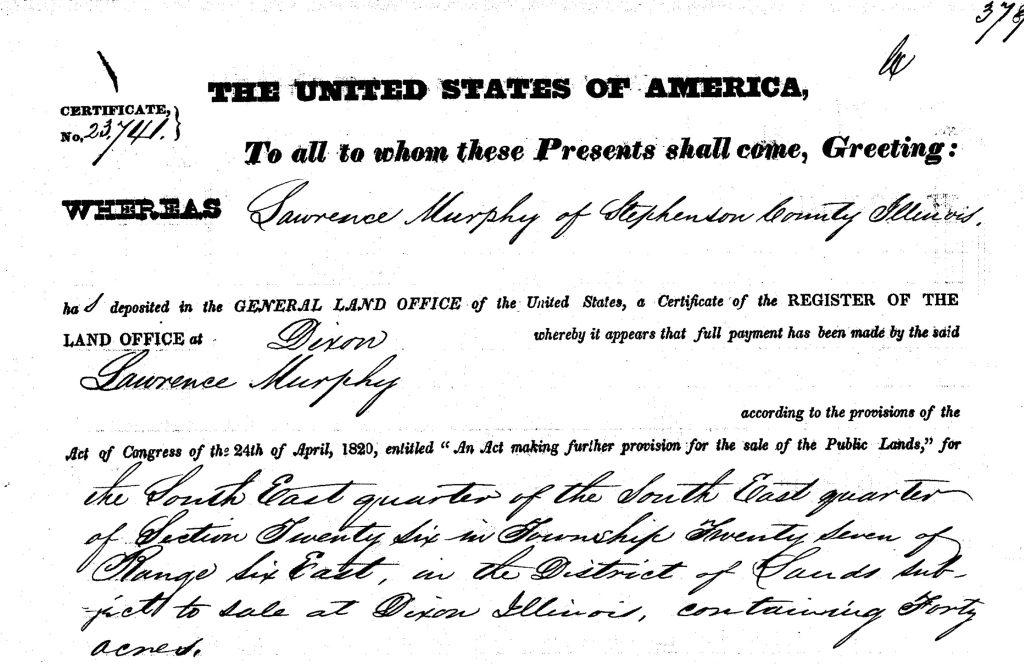
Other Murphys also listed for Erin Township:
- John Murphy – 3/15/1848, Section 27
- Catherine Murphy – 7/1/1848, Section 27
- Mary Murphy – 7/1/1845, Section 34 & 35, also 1/1/1850 Section 34
Elsewhere in Stephenson County – Phebe D Murphy, James Murphy, Thomas Murphy
The 1850 Census of Erin Township provides the following [>] – 886 people, 135 dwellings, 164 families:
- Mary Murphy, 49, born Ireland – no husband listed
- John Murphy, 22, born Canada, also Mary (17), Bridget (15), Michael (12)
- Edward Murphy, 40, born Ireland & Catherine Murphy (39)
- Franklin Murphy 11, William (9), Elizabeth (7), George (5)
- Bartholomew Doyle, 42, born Ireland
- James Doyle 17, born Canada, Sarah 15, Percy ? 12
No record of Elizabeth Harley.
Lawrence and Elizabeths’ first child Ann Murphy was apparently born on a ship in the Irish Sea in 1816. Ann would later marry Joseph Hemming, and their daughter Mary Ann Hemming married John Gould in Iowa in 1855. Their daughter Bridget Gould married Lawrence Morrissey, son of “Uncle Ned” Morrissey. James Franklin Murphy married Mary “Mollie” Burns, daughter of Johnny Burns (Byrne) and Mary Murphy (dau of Pierce Murphy and Ann Doran).
Another daughter of Lawrence J Murphy and Ann Harley was born in 1819: Bridget. She married Asahel Strawn. His biography gives some more information: “The year 1860 saw the arrival of the Strawn family in Kansas and their settlement in Crawford County. They had come a long distance, traveling from Illinois in a covered wagon and one can well believe that the new home, although a primitive one, presented a pleasant sight to the weary travelers. Asahel Strawn and his wife, Bridget (Murphey) Strawn, with their
live children, George W., William A., Betsey AnI, Mahala and Julia, made up the party. Asahel Strawn was born in Canada, a son of Joab Strawn, who was a descendant of William Penn and a Quaker. He went to Canada, perhaps from Pennsylvania, and there became the father of eight sons, each one of these being given a Biblical name and seven grew to maturity. In all probability it would have pleased him had his son
Asahel selected a Quakeress for his bride, but it is not known that he objected to the admirable selection the son made. It was otherwise, however with Laurence and Elizabeth (Harley) Murphey, who, being devout Catholics, could not consent that their daughter Elizabeth should marry outside the church.
Therefore the young people had no other recourse than to run away and marry and this union proved one of domestic happiness. The father of Mrs. Strawn was from County Wexford, Ireland, and was a soldier in the British army and fought at the battle of Waterloo. After he had passed the age for military duty he was given a money pension with which he came to Canada. The graves of Laurence Murphey and wife may be seen in the cemetery of a little village near Freeport, Illinois.” [>]
Ann Murphy & Joseph Hemming
Ann, the first child of Lawrence and Elizabeth Murphy, was baptised on 27th December 1816 in the Roman Catholic catherdral at Portsmouth. She married c. 1833 Joseph Hemming.
How Joseph Hemming came to be in the US is not yet known, nor where Ann would have met Joseph. Likely in Canada?
The family lived in the township of Scio, Washtenaw County, Michigan – just west of Ann Arbor. Founded 25 March 1833, the Township of Scio is named after the Greek Island of Chios (Χίος). Ann and Joseph arrived just as the township was being formally established. Their first child was born there in 1834. Among the noted characters who made their home in Scio was Captain Hayes, who had commanded a privateer during the War of 1812, during which he had captured many prizes and on two occasions had been taken prisoner. After the war he entered the merchant service, and in 1832 settled in Scio. He was a kind hearted man and his language was always that of the sea. His instructions to Clark Sill, who built his house in 1832, were as follows: “She is to be after the most approved model. Her bulwarks are to be large trees, and she is to be seven feet lower deck and five feet upper deck, with port holes on the upper and lower decks, with scuppers on the upper deck. She is to be altogether seaworthy.” >
In the 1850 US Census, Ann (33) and Joseph (45) are living in Scio, Michigan >. Joseph works as a Wagon Maker, with real estate valued at just $200. Their children are given as Joseph (14), Twins Mary Ann and John C. (11), George (9), Ellen (5), and baby James just 2 months old when the census was taken on June 1st.

In the 1860 US Census (16th June), Ann is now Ann Cory, married to John D. Cory. The family is living in Pawnee Territory, Nebraska. [>]. The local post office is Turkey Creek. They are 180 miles west of Tecumseh. Ann married John B. Cory on May 8, 1854 at Boone County, Illinois.
John D. Cory was born in New York in 1814, son of Samuel Cory and Parnel Abiah Brockway. Ann’s younger brother Samuel Murphy was married September 20, 1846, to Parnel Abiah Cory, a daughter of Samuel and Parnel (Brockway) Cory. So, Ann’s second husband was a brother of her brothers wife.

Their first child, Joseph L Hemming, was born in 1834 at Scio, Washtenaw, Michigan. He enlisted in the Iowa 26th Infantry Regiment Aug. 11, 1862. The regiment had the following movements: SERVICE.–Expedition from Helena, Ark., to mouth of White River November 16-21, 1862. Sherman’s Yazoo Expedition December 22, 1862, to January 2, 1863. Chickasaw Bayou December 26-28, 1862. Chickasaw Bluffs December 29. Expedition to Arkansas Post, Ark., January 3-10, 1863. Assault on and capture of Fort Hindman, Arkansas Post, January 10-11. Moved to Young’s Point, La., January 17-23, and duty there until April. Joseph Died of disease (noted as a fever) March 20, 1863, Young’s Point, La. [>]
Their second and third children were twins, born March 3rd 1839 at Scio – Mary Ann and John C.
Mary Ann Hemming married John Gould.
Christopher (John C.) Hemming married Asenath Cole, b. 1827 dau. of Andrew Cole ( a twin?) and Hulda Davis at Tecumseh, Nebraska in 1864. Like his older brother Joseph, he joined the Union side in the Civil War, enlisting in the Iowa 16th Infantry Regiment, F Company on Feb. 4, 1862. Captd. at Atlanta July 23, 1864, died at Millen, Ga., Oct. 22, 1864. [>] HEMMING, John C. Age 22. Residence Massillon, nativity Michigan. Enlisted Feb. 4, 1862. Mustered Feb. 11, 1862. Promoted Fifth Corporal Nov. 19, 1862; Fourth Corporal Feb. 8, 1863. Taken prisoner July 22, 1864. Died while a prisoner Oct. 22, 1864, Millen, Ga. Buried in National Cemetery, Millen, Ga. Grave 136. [>]John C. was taken prisoner of war. Both Joseph and Christopher were farming in Massillon, Cedar County, Iowa at the time of enlisting [>] Asenath received a widows pension of $8 a month after his death >. She later married William Mills of New York, and the couple had 5 children in Johnson County. They also gave birth to twins in 1873 – and named them Romulus and Remus.
SIR,—I have the honor to report the action of the Sixteenth Iowa Veteran Infantry in the battle before Atlanta, Ga., July 22, 1864, resulting in the capture of nearly all of said regiment and myself.
On the morning of July 21st, my regiment charged on the rebel batteries, and, after a desperate assault, lost sixty-five men. The regiment was complimented by General McPherson for its daring bravery. General McPherson’s last words to me, the day he was killed, were: “The old Sixteenth shall be remembered.” On the afternoon of the 21st, the old Iowa brigade was removed to the extreme left flank of Sherman’s army, about two miles from Atlanta. The Sixteenth Iowa formed a line at right angles with the main line of the army. Immediately on the right of the Sixteenth’s works, the Eleventh Iowa established themselves in rifle pits; on a road running between the Eleventh and Sixteenth Iowa’s works were planted two Napoleon guns of the Second Illinois battery protected by heavy works. On the left of the Sixteenth, and a little to the rear, the Fifteenth Iowa had rifle pits. About a hundred yards to the rear of the Sixteenth, the Thirteenth Iowa had breastworks. During the night of the 21st, each regiment of the brigade built substantial rifle pits along the line that I have designated, and each cleared a space of fifty yards in front of its works. Still the heavy underbrush concealed the works of the different regiments from each other’s view.
On the 22d were under arms at daylight, but no enemy appeared. The afternoon before, immediately on our arrival, I had thrown out two companies (B and G) several hundred yards in front, to act as pickets and skirmishers. About noon on the 22d I received an order from General Smith,+ in person, to have my regiment ready to fall in at a minute’s notice, and that he expected me to hold those works to the last, as the safety of the division might depend upon the delay we could occasion the enemy at that point. This was the last order I received that day from any commanding officer. About 1:30 o’clock P. M., our skirmishers in front commenced a brisk firing. I immediately formed the regiment in the entrenchments, and soon after the skirmishers were driven in upon us. I again sent them out, but a strong line of the enemy forced them back. Lieutenant Powers, commanding the battery, opened fire on the advancing enemy, but I requested it stopped until the enemy should get nearer. I ordered my men not to fire a gun until they received my command, no matter how close the enemy came. The rebel line advanced steadily to the charge, and I permitted them to approach to the open space of fifty yards in front of my works, when, cautioning the men to aim well and fire low, I ordered the rear rank to fire, and then the front rank. The response was a terrific and deadly volley from one rank, followed Immediately by another, and then a continuous rapid firing, fast as eager and experienced soldiers could load and discharge their guns. The result of our fire was terrible; the enemy’s line seemed to crumble to the earth, for even those not killed or wounded fell to the ground for protection. Lieutenant Powell’s battery here did excellent execution
Sergeant Major Oliver Anson, in a communication addressed to General Baker* relative to the capture of the officers and men of the Sixteenth and their treatment while prisoners of war, says, in part: “*** We were taken to Macon, and there the enlisted men were separated from the officers, and taken to Andersonville, six miles farther south. The enlisted men of the regiment captured numbered 225. *** The men are suffered to lie out in the open air without any shelter whatever, and many of them are in a manner naked. They do not get enough to eat, and what they do eat is not fit to eat. It is killing the men faster than the army. When I went into the prison the 28th of July, there were over 33,000 prisoners, and on the 7th of September, the issuing clerk told me they issued to 29,553, and since the 28th they had captured the Eighth Iowa Cavalry and some of the Fifth, and a large number from McCook and Stoneman, besides making captures from Sherman’s army, and yet the number ran down in spite of them. *** ” [>]
DIED – Monday, August 1st, 1898, at his residence in this city, Leander Walker Corey, aged 57 years, 11 months and 1 day. The funeral services were held at the U.B. Church, after which the remains were taken to Highland Cemetery, and laid to rest “On Fame’s Eternal Camping Ground.” Mr. Corey was born in Cloud County, Ill., August 30th, 1840, and lived there until he was 14 years of age, when his parents moved to Iowa. At the age of 20 he enlisted in Company F, 16th Reg. of Iowa Volunteers. He took part in many of the most bloody battles of the war, and was finally captured near Atlanta, Georgia, July 22nd, 1864, and was thrown into Andersonville Prison, where he lay until the 13th of June 1865, when he was exchanged and received an honorable discharge. He was married to Miss Sarah Catherine Disney, in Clinton County, Iowa, April 20th 1866. To this union eight children were born, of whom six are still living, two sons, James T. and Joseph W., and four daughters, Mrs. Mary A. Smith, and Addie E., Jennie S., and Elmyra M. Corey. Mr. Corey came to Pottawatomie County, Kansas in 1872, and moved from there to Ottawa County in 1874, where he resided till his death. He lost his sight several years ago, on account of hardships endured during the war, and has patiently groped his way in darkness ever since.
Peter H. Murphy & Mary Ann Young
Peter H. was the first son born to Lawrence Murphy and Elizabeth Harley, c. 1820 in Ireland or England. He emigrated to Canada with the family in 1832, settling in the St. Thomas area. In September 1839, he was serving in the 2nd Battalion of the Incorporated Militia alongside his father and 3 brothers.
Peter married Mary Ann Young, 27 Apr 1849 in Boone County, Illinois. Mary Ann was a daughter of Cyrus Young, and from Southwold, St. Thomas. In 1840, Mary Ann’s father Cyrus Young died. The family farm was in Southwold, and this letter written by her in August of that year enquires as to any monies owing on the land. Source >
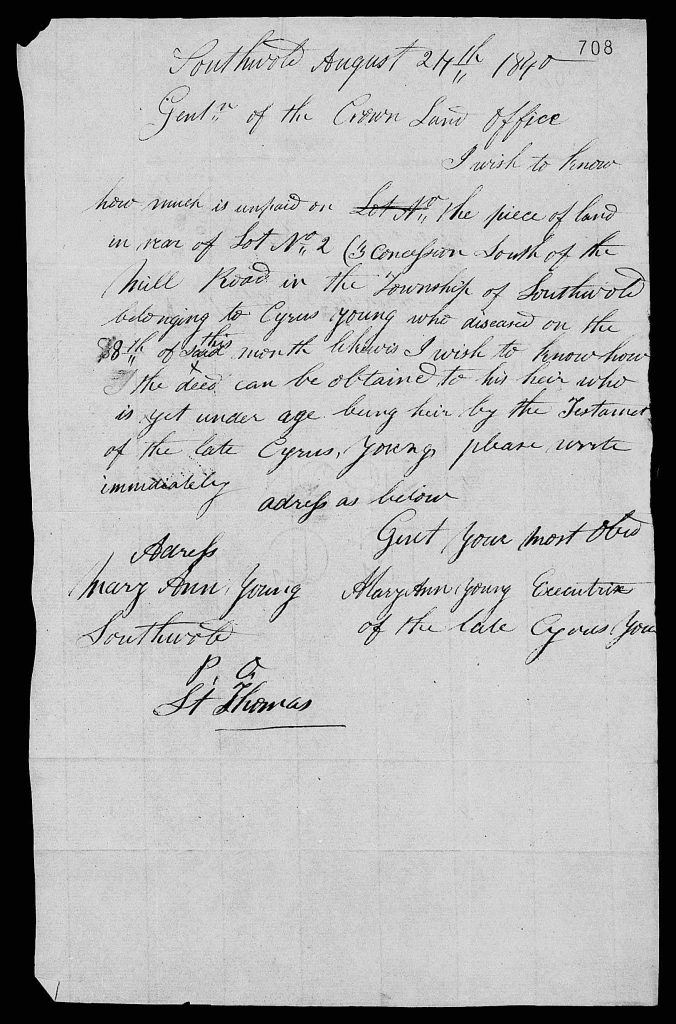
Between 1839 and 1850 the couple moved to Illinois. Peter’s brother Samuel bought a farm here in Franklin Township in 1848. In the 1850 US Census, Peter and Mary Ann are living in Franklin Township, Dekalb, Iowa. >.
Children:
- Cynthia A Murphy b. 29 Jul 1850 Franklin, DeKalb, m. William Rayner, d. 24 Aug 1927 Chicago
- Chester Cyrus Murphy b. Apr 1853 Janesville, Rock, Wisconsin m. Mary Witter, Florence Hemsley, d. Arkansas
- Richard H Murphy b. 14 Sep 1855 Dekorra, Columbia, Wisconsin m. Mina Goodwin, d. 23 Nov 1921 Nora Springs, Iowa
- Alvaro “Allen” Murphy b. 8 Apr 1860 Southwold, Elgin County, Ontario m. Nettie Mosbey, d. 8 Nov 1920 Grove, Oklahoma
By 1853 the family were living in Janesville, Wisconsin, and then in 1855 in Dekorra Wisconsin. In the 1861 Canada Census, Mary Ann and Peter H Murphy now living back in Elgin County with their 4 children, youngest Alvaro born 1860.
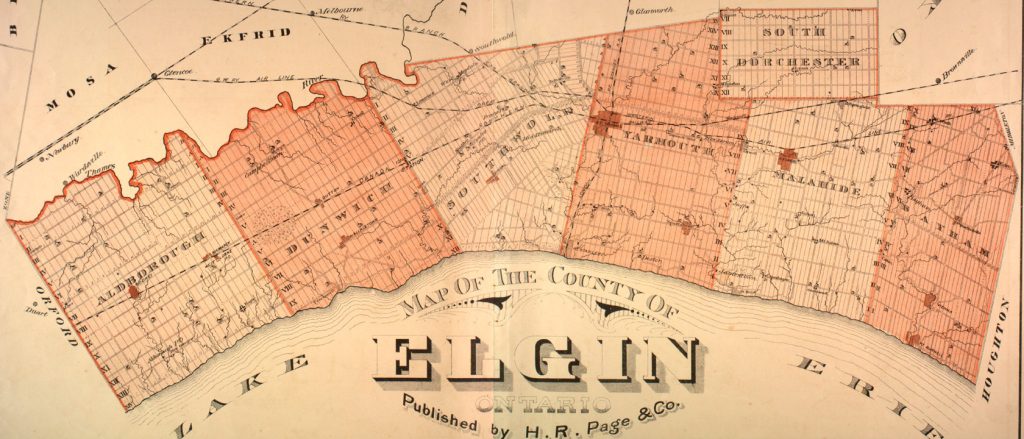
Samuel Murphy & Parnel Abiah Cory
Samuel was born in 1823 in Staffordordshire, England. He emigrated at the age of 8 to Canada with his parents Lawrence and Elizabeth Murphy (Harley). In 1839, Samuel served in the 2nd Battalion, Incorporated Militia based at Chatham, Ontario. His father Lawrence Murphy, and four of his sons served at the same time in 1839 – two sons in the ranks, two in the band.
He married Parnel Abiah Cory September 20, 1846, a daughter of Samuel and Parnel (Bockaway) Cory, natives of Vermont, where that couple was married. Shortly after their marriage they removed to Madison County, Indiana, where Parnel was born, February 22, 1826, and when she was eight years old her parents settled in Kane County, Illinois. They subsequently moved to Kirkland, De Kalb County, Illinois, where Mrs. Murphy lived till her marriage.
In 1850, Samuel and Parnel are living in Franklin Township, DeKalb County [>]. He bought a farm here in 1848.

Children:
- Francisco C. Murphy b. 1847 Illinois
- Laura C. Murphy b. 1848 Illinois
Samuel Murphys biography
His biography is included in the history of Black Hawk County, Iowa (1896) >. “SAMUEL MURPHY was born in Staffordshire, England, September 6, 1823, a son of Lawrence and Elizabeth (Harley) Murphy. When he was three years old his parents moved to County Wexford, Ireland, and at the age of eight years he came with them to America. They first settled near St. Thomas, Canada, residing there till the spring of 1840, when they removed to Winnebago County, Illinois, and a year later removed to Stephenson County, where the father died in 1849, aged sixty-five years, his mother also dying in that county. The father spent about thirty years of his life in the English army, three years of that time being in the navy. He was the father of four sons and two daughters, who accompanied him to America. Samuel Murphy has supported himself since he was ten years old, at first working for the farmers in his neighborhood. In 1848 he bought a farm of sixty-eight acres in DeKalb County, Illinois, paying for the same on time, living there till 1854, when he sold his land and came, in May of that year, to Black Hawk County, Iowa. He at once settled on the place where he now resides, which at that time had no improvements. He lived in a small log house, 14 x 16 feet in dimension, till 1856, when he built a small house in which he lived about twelve years. In 1877 he erected a large frame house at a cost of $1,500, which was burned down in 1877, and in the fall of the same year he built his present residence. The small log house, 12 x 12 feet, at first used as a stable, has now given place to a substantial barn, and the other farm buildings are good. He has now a well-cultivated farm of 125 acres, eighty acres being on section 1, and forty-five on section 2, Washington Township. Mr. Murphy was married September 20, 1846, to Parnel Abiah Cory, a daughter of Samuel and Parnel (Bockaway) Cory, natives of Vermont, where they were married. Shortly after their marriage they removed to Madison County, Indiana, where Mrs. Murphy was born, February 22, 1826, and when she was eight years old her parents settled in Kane County, Illinois. They subsequently moved to Kirkland, De Kalb County, Illinois, where Mrs. Murphy lived till her marriage, her parents residing there till their death. Her mother died in the fall of 1853, at the age of sixty-four years. Her father was one of the first settlers of Kane County, and did much toward helping new settlers who came after him. He was a prominent man in De Kalb County, and was an extensive dealer.”
Franklin Township history
This town, the northwestern most of the County, contains more running streams and a larger surface of timbered land than any other town in the County. It has also some quarries of stone, mostly a soft, inferior limestone, which is used for building, and is also converted into very good lime. Andrew and William Miles and Samuel Corey were probably the first settlers in the town. They came in 1836, following close upon the footsteps of the Indians, who had been removed but a year before. Mr. Miles brought the first fruit trees, and the fine orchard on the Humphreys place was a part of this first importation [>].
A terrible tornado passed through the northern portion of the town of Franklin on one Sunday in May, 1853. It prostrated immense trees, fences, buildings, and everything that stood in its course. The first house struck was Mr. John Youngs’. It was a large building, but in an instant it was lifted up, shattered to splinters, and considerable parts of it carried off’ so far that they were never found. Mrs. Young was killed instantly. The residence of Mr. Ira Dean was next struck. It was torn in pieces ; and a lady relative, who chanced to be visiting there, had her back broken, and died soon after. In a chamber were two boys, engaged in playing cards. Both were blown out of the window, but not seriously injured. Several other houses were unroofed, and some barns destroyed. In 1860 another tornado passed through the central portion of the town, passing, like the former, from the southwest to the northeast. It carried off one house, of which the occupants were absent, and twisted off and carried away huge trees, which could never after be found. Some electric force seemed to be at work in this terrible gale. It tore the ironwork from tools and machinery, and played numberless strange pranks.

